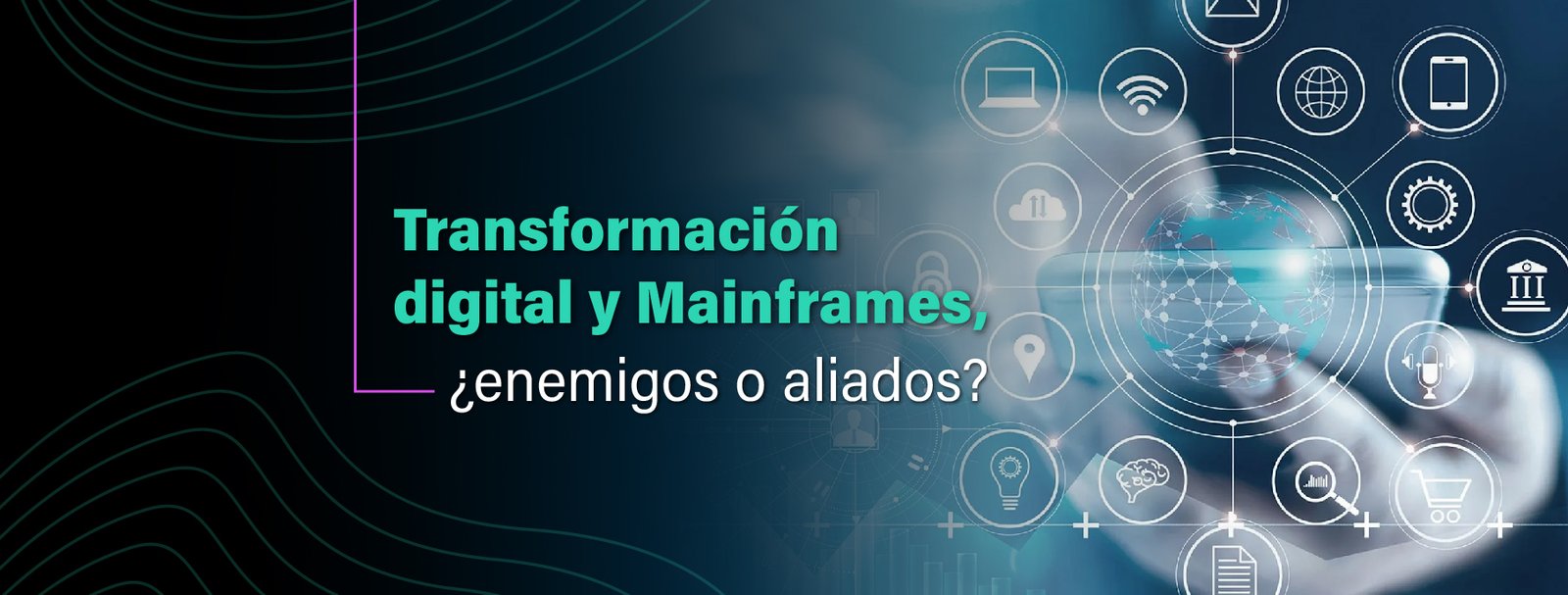Why and how to move forward with mainframe digital transformation
Digital transformation of the mainframe involves modernizing and adapting its capabilities so that they can properly integrate with emerging technologies.
This is a process that may include updating systems and applications for a Greater efficiency and scalability, the implementation of agile practices, and the migration of part of the workloads to cloud environments.
That is, the digital transformation of the mainframe does not necessarily lie in replacing it with a Full migration to a cloud environment, but in its optimization and advancement towards distributed models. Even more so considering that its hardware and software support is constantly updated.
In this article we analyze why the digital transformation of organizations is not contrary to the use of these powerful devices, but quite the opposite: Why mainframes are key allies for achieving successful innovation processes.
Mainframe modernization: current state of affairs and trends
The 86% of the enterprises has not yet completed its mainframe modernization processes, despite the 90% saying they are critical to its operations.
This is revealed by a Kyndryl report, which also highlights that The 99% companies are taking a hybrid approach to mainframe modernization, moving the 37% from its application portfolio to the cloud.
Only 1% is moving all of its workloads completely off the mainframe.
Among the results of the report it is shown that The 74% prefers a journey led by technology partners, to ensure your project runs as smoothly as possible and fill skills gaps where necessary.
For 67% respondents, the focus for mainframe modernization is on optimizing performance and capacity and rationalizing software, Strategically choosing which applications to keep, replace, retire or consolidate.
Another popular approach includes integrating DevSecOps with the mainframe environment (56%), which brings together development, IT operations and security for optimized processes.
The 48% surveyed by Kyndryl is upgrading mainframe programs to the latest version in order to improve performance.
Those involved in the measurement maintain that the three main advantages of using an integrated approach are that organizations:
- Innovate faster (48%)
- Increase flexibility (41%)
- Unlock valuable data from the mainframe so it can be accessed by cloud applications (48%)
About a quarter of companies (24%) are integrating mainframe applications with the cloud.
The 19% chooses to employ additional as-a-service options, along with the Infrastructure as a Service (IaaS) cloud computing model.
Factors driving mainframe modernization
Mainframe digital transformation is often driven by a variety of business needs, and is premised on the importance of leveraging what already exists and is available on IBM z®.
Likewise, the content of the core applications. This is how it is explained Carina Hermida, Account Manager at IT Patagonia, who points out that there is no need to reinvent the wheel. “The core applications are on the mainframe. So, it is not about rewriting everything, but about define how to make use of the applications that are on the Mainframe through microservices”, defines Carina.
“This can be solved through APIs that access COBOL structures and can expose them to the distributed world, so that they can be consumed by applications in the Open world,” he adds.

Technology is advancing and it is necessary to reach more modern platforms and new generation applications. The key is to see how the Asset is linked to current environments and applications..
As for the advantages that drive the mainframe modernizationKyndryl's study shows that companies reported a 9-11% increase in profits upon completion of projects.
Specifically, they noted that Transforming their critical operations for the future helped them increase their profits by up to 11%.
These positive results led the surveyed companies to identify three main reasons for modernizing their mainframe infrastructures:
- Data Accessibility (51%)
- Improving innovation (48%)
- Greater flexibility (41%)
Based on these considerations, the needs of organizations in relation to mainframe modernization can also be identified:
1. Performance Optimization, increasing processing capacity and reducing response times.
2. Reduction of operating costs in the long term.
3. Increase efficiency and scalability of systems to meet the current and future demands of the organization and its users.
4. Improving business agility, allowing organizations to adapt more quickly to market demands and changes in business requirements.
5. Integration with modern technologies, such as the cloud, artificial intelligence and real-time data analysis, gives companies the opportunity to automate processes, enhance their operational level, and increase competitiveness.
6. Improve usability, functionality and integration capabilities with other systems and applications.
7. Compliance with regulations and standards, to comply with current legal requirements.
8. Protecting data security, as a crucial aspect to safeguard the privacy and integrity of information and prevent identity theft and other cyber risks.
In the case of financial institutions, we must also include the need to Optimize batch processes and reduce the batch window.
Challenges for the digital transformation of the mainframe
Among the most relevant challenges facing Mainframe infrastructure modernization are the following:
1. Cultural transformation
For Carina, the main challenge is linked to overcoming the mental barriers that many organizations have, accustomed to traditional processes and technologies.
As is the inertia of professionals who are retiring. A situation that raises the issue of who will support the mainframe, as we will see later.
That is why Digital transformation involves changes in organizational culture and in the development, deployment and operation practices of applications..
Also in incorporating habits of continuous improvement, such as keep informed about market trends regularly, since there is a lack of appetite on the part of IT professionals to want to know the latest developments related to the modernization of mainframe infrastructures.
This is a behavior that needs to be modified in order to respond efficiently to the challenges posed by the market.
2. Risk assessment and business continuity
When migrating mainframe applications, one must consider the risks of business interruption, which can occur if not planned and executed properly.
On the other hand, digital transformation must Ensure continuity of mainframe application integration and minimize its impact on other business systems and operations.
In addition, you have to Ensure the integrity, security and availability of business-critical data, during and after the transformation process.

3. Availability of resources
In economic terms, the challenge lies in having an adequate budget and resources to carry out the modernization process effectively.
Resource availability also includes staying up to date with the latest technology available.
In addition, it is important to keep up to date with the latest versions of hardware and software, in order to advance with the digital transformation process through technologies such as microservices and monitors that use containers.
4. Lack of available talent
Another key challenge is addressing the skills and knowledge shortage in mainframe systems maintenance and development.
As Carina explains, people who know about z teams are retiring, and this situation puts companies at a critical point. “If new talents are not generated, who understand and know about z, not only the experience in this technology will be lost, but also the knowledge to access the information,” she warns.
The lack of qualified professionals that can handle the updates required by a Mainframe is increasing year after year.
In today's job market it is very difficult to find specialists, mainly system programmers and COBOL developers.
Hence, the importance of outsourcing modernization processes with companies that have Highly trained professionals with experience in this type of projects.
As Kyndryl’s report reflects, 74% of organizations prefer a partner-led journey to ensure their project runs as smoothly as possible and to fill skills gaps where needed.
In response to this need, at IT Patagonia we created the initiative Upskilling Program, with which we attract the talent that will implement the mainframe modernization strategy and train them as systems programmers, taking into account that new people will be needed to administer the z.
In parallel, the key is making the mainframe attractive to new generations. And that the person who uses a graphic ID for Python or for Java, You can also do this to develop a COBOL program., with the editing mechanism.
“We must try to reuse the Mainframe asset, the CICS applications and expose them through the use of Microservices,” emphasizes Carina.
5. Understanding the benefits of mainframe modernization
As we highlighted, the Modernization of mainframe projects produces a 9% increase in profitability.
As evidenced by the fact that organizations participating in the Kyndryl study saved $12.5 billion in one year by modernizing their mainframes.
Is there a formula for achieving mainframe digital transformation?
It is generally held that there is no single or universal formula for successfully achieving mainframe digital transformation, as each organization has its own specific needs, challenges and contexts.
However, and beyond the lack of winning formulas, some can be considered practices to help guide the process.
In this sense, Carina Hermida recommends as a first measure modernize the interface with the z.
The important thing, prior to determining the paths to follow, is to be able to have a clear understanding of the current state, based on a thorough assessment of applications, infrastructure, data and processes.
The objective is Identify areas of opportunity and potential obstacles.
It is also key Set clear and measurable goals for digital transformationThey must be aligned with the organization's vision and strategy, to guide the process and evaluate its success.
In addition, there must be commitment and active support from the organization's senior management and key IT and business teams to ensure the necessary support and allocation of appropriate resources.
All stakeholders in the digital transformation process must be involved: end users, customers, development teams, operations, security and compliance.
Similarly, it can be very beneficial to take an incremental and pragmatic approach, breaking the process down into smaller, more manageable steps, with early and frequent delivery of value to the organization.
And use agile methodologies such as Scrum or Kanban to manage the digital transformation process in a flexible and adaptive way, promoting collaboration, transparency and continuous delivery of value.
We also do not want to fail to mention the benefits that an effective change management plan can bring to addressing the cultural and organizational aspects of digital transformation, providing appropriate communication, training and support to affected employees.

Finally, key performance metrics must be established to assess the progress and impact of digital transformation, in order to continuously adjust and improve the approach and processes.
By following these practices, organizations can increase the likelihood of achieving a successful mainframe digital transformation and reap the benefits of a modernized and adaptable infrastructure.
Paths to modernizing the mainframe
While experts agree that no two mainframe modernization photos are the same in terms of projects and roadmaps, and that there are no points of comparison between one client's situation and another, there are several paths to modernizing a mainframe.
In a first general assessment, one must consider whether modernizing the mainframe implies staying on it, migrating non-core applications, or migrating everything.
As we saw previously when analyzing the Kyndryl survey results, 99% of enterprises are taking a hybrid approach to mainframe modernization (non-core migration), moving 37% of their application portfolio to the cloud.
One 74% reported that their transition to the cloud is underway or complete and more than 40% are integrating with cloud-native services, which can make applications and data more accessible and facilitate more flexible ways of working.
Only 1% is moving all of its workloads completely off the mainframe.
Depending on the specific needs and capabilities of each company, these paths may include:
1. Updating mainframe hardware and software to improve its performance, capacity and compatibility with emerging technologies.
This includes the adoption of service-oriented architectures, to facilitate integration with other systems and applications. For example:
- Microservices: a form of Modernize and decompose legacy applications to make them more flexible, scalable and easier to maintain.
It may involve rewriting or restructuring existing applications, to break them down into smaller, modular services that are feasible to develop and maintain in a more agile way. This allows for a Greater agility and flexibility in software development and deployment in a mainframe environment.
- IDz Tools (IBM Developer for z/OS): Designed for software developers working in mainframe environments, they provide an integrated environment that includes code editors, debuggers, static analysis tools, terminal emulators, and other utilities, which facilitate the development and debugging of mainframe applications.
- VS Code (Visual Studio Code)
2. Optimization and adaptation of applications mainframe existing ones to improve their performance, usability and ability to integrate with modern technologies.
3. Migration to the cloud: transfer mainframe workloads and applications to cloud environments, to improve scalability, flexibility and operational efficiency. We are not talking about a complete migration, but rather about specific processes or tasks.
4. Implementing web services to facilitate integration with modern systems and applications through APIs.
For example, in the case of a mobile home banking application, the API Rest format is generally used, which allows the transformation of data coming from transactions running on the Mainframe so that they can be accessed from a cell phone.
5. Redesign of application user interfaces mainframes to make them more intuitive and user-friendly. This can improve the user experience and facilitate the adoption of applications by employees and customers.
6. Adoption of Agile and DevOps development practices to accelerate the software lifecycle and improve collaboration between teams. In addition, rapid adaptation to changes in business and market requirements is facilitated.
7. Incorporating automation tools to simplify and streamline mainframe application management, maintenance and deployment tasks, help reduce operating costs and improve efficiency in mainframe operations.
8. Using virtualization and containerization technologies, to optimize resource usage and facilitate the migration and deployment of mainframe applications.
Conclusion
Organizations that intend to continue running workloads on the mainframe know they must continually modernize to realize the benefits of improved performance, reliability and increased innovation in a rapidly changing business world.
Committing to digital transformation is the first step towards having infrastructures prepared to face and solve the operational challenges that all companies face today.
At IT Patagonia we implement projects of Modernization of mainframe environments and construction of optimized environments, for 35 years.
Contact us for receive specialized advice by our team of mainframe specialists.

